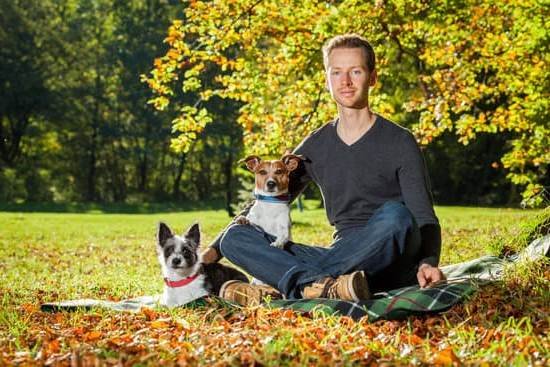Positive reinforcement dog training is a highly effective and gentle approach to teaching your canine companion good behavior. This training method focuses on rewarding desirable behaviors, making it an enjoyable experience for both the dog and the owner. Positive reinforcement dog training not only helps in shaping a well-behaved and happy pet but also strengthens the bond between you and your furry friend.
Understanding the science behind positive reinforcement is crucial to implementing this training method effectively. By using rewards such as treats, praise, or playtime, dogs learn to associate certain behaviors with positive outcomes. This creates a strong motivation for them to repeat those behaviors in the future.
The benefits of positive reinforcement training extend beyond just obedience. It can also help in correcting behavioral issues such as aggression or anxiety, while promoting confidence and trust in the dog-owner relationship. In this article, we will delve into the fundamentals of positive reinforcement training, explore its scientific principles, and provide practical tips for getting started with this rewarding approach to canine education.
Understanding the Science Behind Positive Reinforcement
Positive reinforcement dog training is a scientifically proven method that relies on the principles of operant conditioning to modify your pet’s behavior. This technique employs the use of rewards, such as treats, praise, or playtime, to encourage desirable actions and discourage unwanted behaviors. Understanding the science behind positive reinforcement can provide insight into why it is such an effective training tool for dogs.
The Science of Operant Conditioning
Positive reinforcement is based on the concept of operant conditioning, which was pioneered by psychologist B.F. Skinner. This theory suggests that behavior is influenced by its consequences – if a behavior results in a favorable outcome, it is more likely to be repeated. With positive reinforcement, dogs learn to associate good behavior with rewards, making them more inclined to exhibit those behaviors in the future.
The Role of Neurotransmitters
When a dog receives a reward during positive reinforcement training, it triggers the release of feel-good neurotransmitters such as dopamine and serotonin in their brain. These chemicals create a sense of pleasure and satisfaction, strengthening the association between the desired behavior and the reward. Over time, this leads to lasting changes in your pet’s behavior as they strive to continue receiving positive feedback.
The Importance of Consistency
Consistency plays a key role in positive reinforcement dog training because it helps reinforce the link between good behavior and rewards. By consistently rewarding your dog for specific actions, you are effectively shaping their behavior and fostering a deeper understanding of what is expected from them. The science behind positive reinforcement emphasizes the need for clear communication and reliable consequences to ensure successful training outcomes.
The Benefits of Positive Reinforcement Training for Dogs and Owners
Positive reinforcement dog training has become increasingly popular among dog owners and trainers due to its effectiveness in shaping desired behaviors in dogs. This method of training relies on rewarding good behavior with treats, praise, or toys, rather than punishing unwanted behavior. The benefits of positive reinforcement training for both dogs and owners are numerous.
One of the key benefits of positive reinforcement training is that it creates a strong bond between the dog and their owner. By using rewards to reinforce good behavior, dogs learn to associate obedience and good manners with positive experiences, leading to a trusting and loving relationship between the dog and their owner. This can result in a more obedient and well-behaved pet, as the dog is motivated to listen and follow commands in order to receive rewards.
Another benefit of positive reinforcement training is that it fosters a happy and confident dog. By focusing on rewarding good behavior rather than punishing bad behavior, dogs are more likely to feel secure and have higher self-esteem. This can be especially beneficial for rescued or shy dogs who may have a history of abuse or neglect. Positive reinforcement helps them build trust and confidence, leading to a happier and well-adjusted pet.
Furthermore, positive reinforcement training also benefits owners by making the training process more enjoyable and less stressful. Instead of constantly correcting bad behavior, owners can focus on rewarding their dog for doing the right thing. This not only makes training sessions more fun for both the owner and the dog but also encourages a positive atmosphere where both parties can enjoy spending time together while working towards common goals through positive experiences.
Getting Started With Positive Reinforcement Training
Positive reinforcement dog training is a method of teaching dogs new behaviors and skills by rewarding desired behaviors with treats, praise, or other forms of positive reinforcement. This method focuses on promoting good behavior through rewards, rather than punishing bad behavior. Positive reinforcement training is based on the principle that behaviors that are rewarded are more likely to be repeated, making it an effective and humane way to train dogs.
To get started with positive reinforcement training, here are some basic techniques and tips to keep in mind:
- Use high-value treats: When starting with positive reinforcement training, it’s important to use treats that your dog finds highly motivating. This could be pieces of cooked chicken, cheese, or commercial dog treats.
- Timing is key: It’s essential to give the reward immediately after your dog performs the desired behavior. This helps them understand what they’re being rewarded for.
- Be consistent: Consistency is crucial in positive reinforcement training. Make sure everyone in your household is on the same page about which behaviors are being reinforced and how they should be rewarded.
Positive reinforcement dog training has numerous benefits for both dogs and their owners. Not only does it help build a strong bond between the dog and the owner, but it also promotes a positive learning environment for the pet. When using positive reinforcement, dogs tend to be more eager and willing to learn new behaviors, making the training process more enjoyable for both parties involved.
It’s important for owners to understand that positive reinforcement training requires patience and consistency. It may take time for dogs to fully grasp new commands or behaviors, so being patient and persistent is key. By following these basic principles of positive reinforcement training, owners can set their dogs up for success in learning new skills and behaviors while strengthening their relationship with their furry companions.
Common Training Mistakes to Avoid and How Positive Reinforcement Can Help
When it comes to training your dog, there are some common mistakes that many owners make. These mistakes can impede the training process and create frustration for both the dog and the owner. However, positive reinforcement dog training can help address and overcome these issues.
One of the most common training mistakes is using punishment-based methods. This can include yelling at or physically disciplining your dog when they do something wrong. Not only is this harmful to the dog’s well-being, but it can also lead to fear, anxiety, and aggression. Positive reinforcement training focuses on rewarding good behavior, which creates a more positive and trusting relationship between you and your dog.
Another mistake is inconsistency in training. It’s important to establish clear expectations and be consistent in reinforcing those expectations. Positive reinforcement provides a clear structure for your dog to understand what behaviors are desirable through consistent rewards for those behaviors.
Finally, neglecting socialization is another common mistake that can be addressed with positive reinforcement training. Socialization is crucial for a well-behaved and well-adjusted dog, but it can be intimidating for some owners to expose their dogs to new environments and experiences. Positive reinforcement techniques can help make socialization a positive experience for your dog, encouraging them to feel comfortable in new situations.
Positive Reinforcement Dog Training Data
| Common Training Mistake | How Positive Reinforcement Can Help |
|---|---|
| Using punishment-based methods | Rewards good behavior instead of punishing bad behavior |
| Inconsistency in training | Establishes clear expectations and provides consistent rewards for desired behaviors |
| Neglecting socialization | Makes socialization a positive experience by using rewards for engaging in new environments and experiences |
Positive Reinforcement Techniques for Specific Behaviors (Eg Sit, Stay, Come, Leash Training)
Positive reinforcement dog training is a method of training that focuses on rewarding your dog for good behavior rather than punishing them for bad behavior. This type of training relies on the principles of operant conditioning, which involves using positive reinforcement to encourage desired behaviors. By rewarding your dog with treats, praise, or toys when they exhibit the behaviors you want, you can effectively teach them to repeat those behaviors in the future.
Understanding the Science Behind Positive Reinforcement
The science behind positive reinforcement dog training lies in the concept of associative learning. When a dog receives a reward for performing a specific behavior, such as sitting or staying, they begin to associate that behavior with a positive outcome. Over time, this association strengthens, making it more likely that the dog will continue to perform the desired behavior in order to receive the reward.
The Benefits of Positive Reinforcement Training for Dogs and Owners
There are numerous benefits to using positive reinforcement training with your dog. Not only does it create a stronger bond between you and your pet, but it also helps to build trust and confidence in your dog. Additionally, positive reinforcement training has been shown to be more effective than punishment-based methods in modifying behavior and reducing aggression in dogs. For owners, this type of training also makes the process more enjoyable and less stressful compared to traditional training methods.
| Benefit | Description |
|---|---|
| Creates strong bond | Positive reinforcement creates a stronger bond between owner and pet. |
| Builds trust and confidence | Dogs become more confident when they are rewarded for good behavior. |
| Effective in reducing aggression | This method has been proven effective in reducing aggressive behavior in dogs. |
Overcoming Challenges in Positive Reinforcement Training
Positive reinforcement dog training is an effective and humane method of teaching your furry friend good behaviors. However, it’s important to acknowledge that, like any training method, positive reinforcement comes with its own set of challenges. Overcoming these challenges is crucial to ensure that your dog responds positively to the training and continues to exhibit good behavior.
One common challenge in positive reinforcement dog training is inconsistency. This can occur when different family members or individuals involved in the dog’s care apply different rules or methods of reinforcing positive behavior. To overcome this challenge, it’s important for everyone involved in the dog’s training and care to be on the same page. Consistency in applying positive reinforcement techniques will help the dog understand what is expected and reinforce those desired behaviors more effectively.
Another challenge is dealing with distractions during training sessions. Dogs are naturally curious and easily distracted, which can make it difficult for them to focus on the task at hand. To address this challenge, it’s important to gradually introduce distractions during training sessions and reinforce positive behavior in different environments. This will help the dog generalize their understanding of commands and behaviors across various settings.
In addition, some dogs may have specific behavioral issues or fears that can present challenges in positive reinforcement training. For example, a dog may have a fear of loud noises or strangers, making it difficult for them to stay calm and respond positively to training cues in certain situations.
In such cases, it’s important to work with a professional trainer who has experience in using positive reinforcement techniques to address specific behavioral issues and fears in dogs. Working collaboratively with a trainer can help identify underlying causes of the problem behavior and develop a customized positive reinforcement plan to address it effectively.
- Consistency in application between family members
- Gradually introducing distractions
- Seeking professional help for specific behavioral issues
Success Stories
Positive reinforcement training has been proven to be effective in shaping a dog’s behavior in a positive and humane way. Many dog owners have successfully utilized this method to train their pets, leading to improved behavior and strengthened bonds between owner and pet. Here are some real-life examples of how positive reinforcement training has worked wonders for both dogs and their owners.
Transforming Aggressive Behavior
One success story involves a dog named Max, who used to display aggressive behavior towards other dogs during walks. His owner, Sarah, decided to use positive reinforcement techniques to address this issue. By using treats and praise whenever Max displayed calm behavior around other dogs, Sarah was able to gradually change his response. Over time, Max learned that good behavior resulted in rewards, and his aggression diminished significantly.
Improving Recall
Another example is Lucy, a playful but stubborn pup who would often ignore her owner’s calls when off-leash. Through positive reinforcement training, Lucy’s owner implemented a reward system every time she came when called. Whether it was through treats or playtime, Lucy quickly learned that responding to her owner’s commands led to positive outcomes. As a result, Lucy now reliably comes when called, making outdoor activities more enjoyable for both her and her owner.
Leash Training Success
Positive reinforcement training also proved effective for leash training with Bella, a rescue dog with a strong pulling habit during walks. Rather than resorting to harsh training methods, Bella’s owner focused on rewarding her for walking politely on the leash. Each time Bella walked without pulling, she received verbal praise and the occasional treat. With consistent application of positive reinforcement techniques, Bella’s leash manners improved significantly.
These success stories demonstrate the power of positive reinforcement dog training in addressing various behavioral issues while strengthening the bond between owners and their pets. Through patience, consistency, and the use of rewards, dog owners can witness remarkable improvements in their furry companions’ behavior without resorting to punishment or intimidation tactics.
Conclusion
Positive reinforcement dog training has proven to be an effective and humane method for teaching dogs new behaviors and shaping their responses. By using positive reinforcement techniques, owners can build a strong, trusting bond with their canine companions while also achieving desired training outcomes. Understanding the science behind positive reinforcement is essential in order to fully grasp its benefits and how it works.
As more people recognize the value of positive reinforcement dog training, the future looks promising for this approach. Its focus on reward-based learning and non-confrontational methods aligns with modern attitudes towards animal welfare and ethical treatment. With increased awareness and education, more owners are likely to embrace positive reinforcement training as the standard for working with their dogs.
There are numerous resources available for those interested in getting started with positive reinforcement dog training. From classes at local training centers to online tutorials and books, owners have access to a wealth of information that can help them implement these techniques effectively. By committing to using positive reinforcement methods, dog owners can empower themselves to establish a harmonious partnership with their pets based on trust, respect, and mutual understanding.
Frequently Asked Questions
How Do You Teach a Dog Positive Reinforcement?
Teaching a dog positive reinforcement involves rewarding good behavior with treats, praise, or toys. When the dog does something desired, you immediately reward them to reinforce the behavior and increase the likelihood of it being repeated.
Does Positive Training Work for Dogs?
Positive training has been shown to be effective for dogs. It focuses on rewarding desired behaviors rather than punishing unwanted ones. This approach helps build a strong bond between the owner and the dog while promoting a positive learning experience.
Is Positive Punishment Effective in Dog Training?
Positive punishment, such as scolding or physical corrections, is not as effective in dog training as positive reinforcement. While punishment may stop a behavior temporarily, it can lead to fear or anxiety in the dog, and they may not fully understand what they are being punished for. This can ultimately harm the relationship between the owner and the dog.

Welcome to the blog! I am a professional dog trainer and have been working with dogs for many years. In this blog, I will be discussing various topics related to dog training, including tips, tricks, and advice. I hope you find this information helpful and informative. Thanks for reading!





